Vanishing North
An occasional series in the Star Tribune documenting the biodiversity crisis and the people struggling to head off extinction for Minnesota’s most vulnerable animals and plants.
On the grounds of the Minnesota Zoo, inside an old shipping container turned into a laboratory, two biologists prepared to wake 67 caterpillars from their frozen winter sleep.
Cale Nordmeyer and Erik Runquist carefully removed plastic cups that housed the green Poweshiek skipperling caterpillars from a freezer. They placed them into an Igloo cooler just big enough to carry a six-pack of beer.
If the creatures survived the next two and half months to be released in the wild, they could account for somewhere between one-third and one-fifth of wild Poweshiek butterflies left on this earth.
"I'm not letting this cooler out of my sight," Nordmeyer said.
This prairie butterfly suffered one of the most sudden and complete population collapses of any species in North American history. They once numbered in the millions in Minnesota, filling every square mile of the state's grasslands — and just about every open field where people cared to look.
The thumbnail-sized butterflies are a silvery orange and brown, the white veins on their wings giving them a smart pinstripe look. They fly in short bursts, almost skipping from one blade of grass to another. Even at rest, their wings are poised like tiny fighter jets, ready to launch.
They ranged from the Dakotas to Michigan, but Minnesota was their stronghold. At their height, more than half of all Poweshiek skipperlings lived in Minnesota. It could be called "the most Minnesota butterfly in the world," Runquist said, although they were named for the county in Iowa where they were first documented.
Then, 20 years ago, they vanished.
They're extirpated now in Minnesota, or extinct here, as far as anyone knows. And on that morning in early May, as Runquist and Nordmeyer took the caterpillars out of their freezer, fewer than 500 were thought to exist anywhere in the wild, all in two locations — a wetlands complex in central Michigan and a prairie preserve in Manitoba.

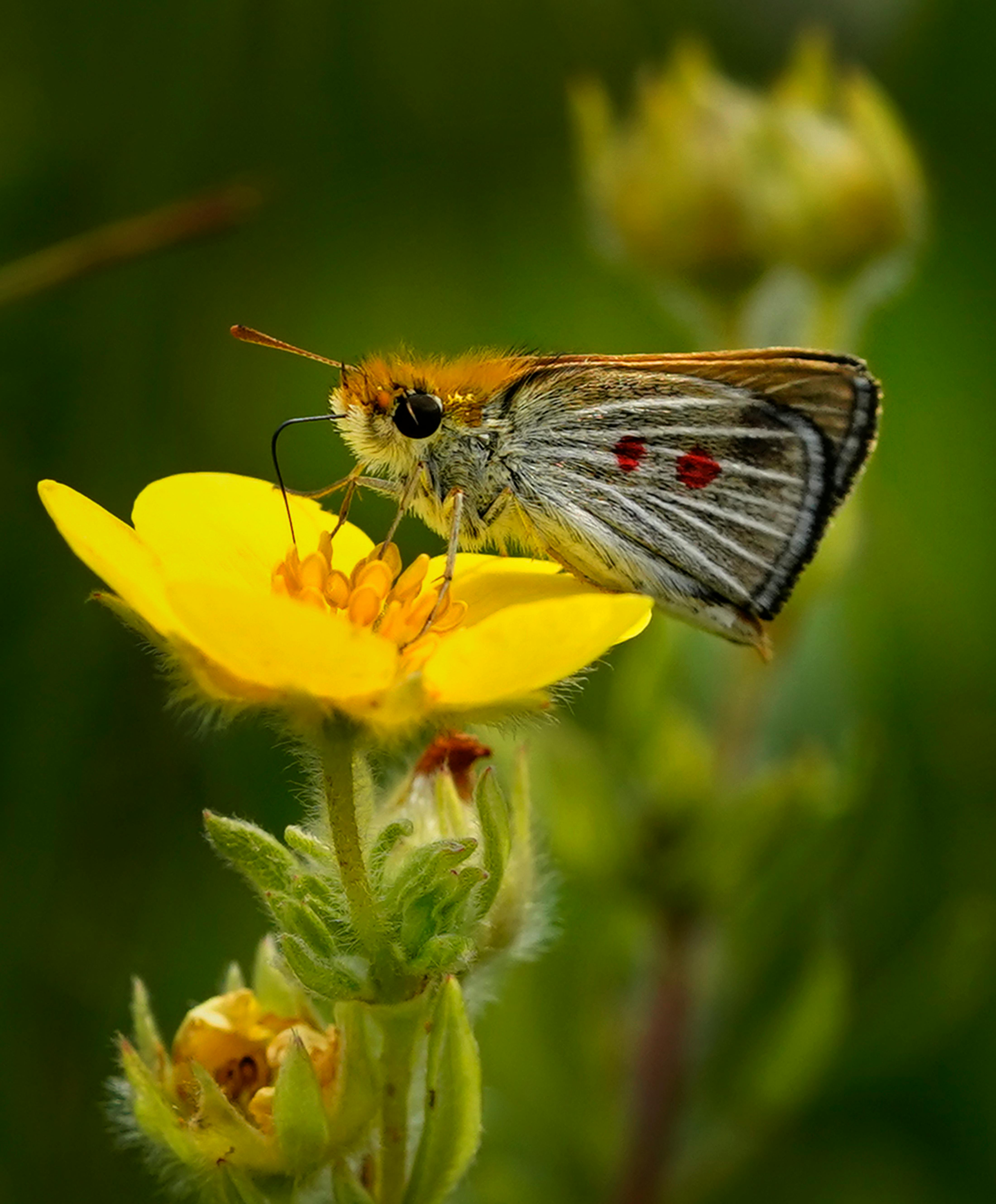
The Minnesota Zoo biologists would spend the coming weeks feeding the caterpillars, helping them transform into butterflies and releasing them in Michigan in a last-ditch effort to reverse the rapidly dwindling wild population. To get to this point took years of experimentation and frustration, with no guarantee of success. If the zoo-raised butterflies mate in the wild and lay eggs there, all of that work could pay off.
Nordmeyer carried the cooler to his car, aware that the future of the species could be inside. "It's a big day," Runquist said.
On long drives Nordmeyer buckles up the cooler. On short ones like this — to the other side of the zoo parking lot to a screen tent where the caterpillars will wake up — the cooler stays on Nordmeyer's lap.
Nordmeyer is compact and bearded, with thick brown hair and intricate tattoos of two Dakota skippers on his forearm named HA11 and SF10B8 — the first two endangered butterflies he ever got to breed at the zoo.
Inside the tent he carefully lifted the 67 caterpillars out from under a type of plaster covering them in the cups. He placed each one on its own individual blade of prairie dropseed grass, their favorite.
True homebodies, Poweshiek skipperlings don't migrate like monarchs. They spend nearly all of their one-year lives — 11 months — as caterpillars in the same field where they were born. They don't eat themselves out of a home as other caterpillars do. They take just two bites, perfect cartoonish semi-circles, one on each edge of the blade, and then move on to the next.
Nordmeyer speculated that the two bites made a natural breaking point for when grazers like bison came through. Rather than be uprooted, the grass would break at the bite marks, leaving the caterpillars safe below. Robert Dana, a retired state Department of Natural Resources prairie ecologist, suspects the more ragged the edge of a leaf looked to predators — typically dragonflies, parasitic wasps and spiders — the harder it would be for them to spot the outlines of Poweshiek caterpillars.
In winter, the caterpillars hunker down near the bottom of a blade of grass, surviving all the snow, wind and 40-below nights of a Minnesota prairie. To keep from freezing to death, their bodies produce a chemical similar to propylene glycol, a common non-toxic antifreeze.
"What's so scary is these things were able to handle the extreme temperatures of Minnesota, but they can't handle whatever extremes they were getting thrown at them over the last two decades," Nordmeyer said.
The loss and fragmentation of their grassland habitat, diminished genetic diversity, severe weather, climate change, invasive species, farm chemicals — there are overwhelming pressures on the butterfly, as there are on insects and pollinators globally. Scientists estimate that about 41% of insect species have been pushed toward extinction.
Minnesota's warming climate has brought earlier and more erratic springs, which could be luring Poweshiek caterpillars out of hibernation, or diapause, too soon and leaving them vulnerable to a refreeze, Michigan conservation scientist David Cuthrell said.
But a key culprit in their demise appears to be insecticide drift. The butterfly's sudden disappearance occurred in the early 2000s, as farmers started increasingly using broad spectrum insecticides sprayed by air to control the destructive non-native soybean aphids infesting fields, Runquist and University of Minnesota entomologist George Heimpel reported in 2017.
Popular aphid sprays such as Warrior, a pyrethroid, and chlorpyrifos products such as Lorsban, are toxic to invertebrates, according to the report. Chlorpyrifos was recently banned for most uses. Research continues on the aphid spray connection to the Poweshiek skipperling die-off. So does work on whether the simultaneous spread of neonicotinoid insecticides played a role. So far they've found no correlation with neonics, Nordmeyer said.
They are learning how to raise the butterflies even as they try to figure out exactly what killed them. Nobody knows whether they're rearing enough of them to survive in the wild. It's possible that the Poweshieks have already crossed the threshold and are functionally dead, in what is called an extinction vortex.
The Poweshiek recovery program started at the Minnesota Zoo in 2016, the majority of it paid for by federal grants from the U.S. Fish and Wildlife Service through the Great Lakes Restoration Initiative totaling about $100,000 a year. The partnership has grown to include the John Ball Zoo in Grand Rapids, financed separately, and the Assiniboine Park Zoo in Winnipeg, Manitoba.
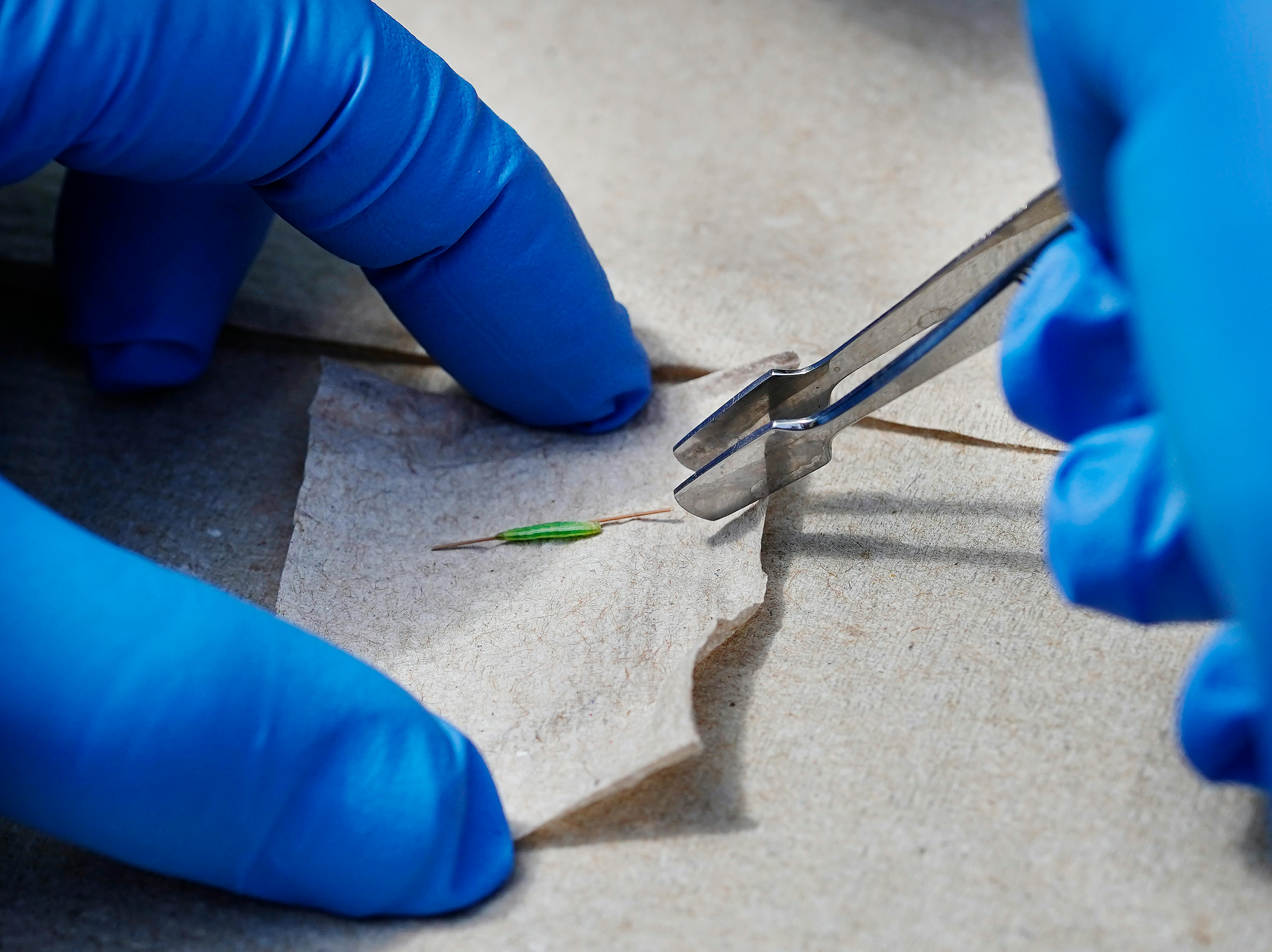
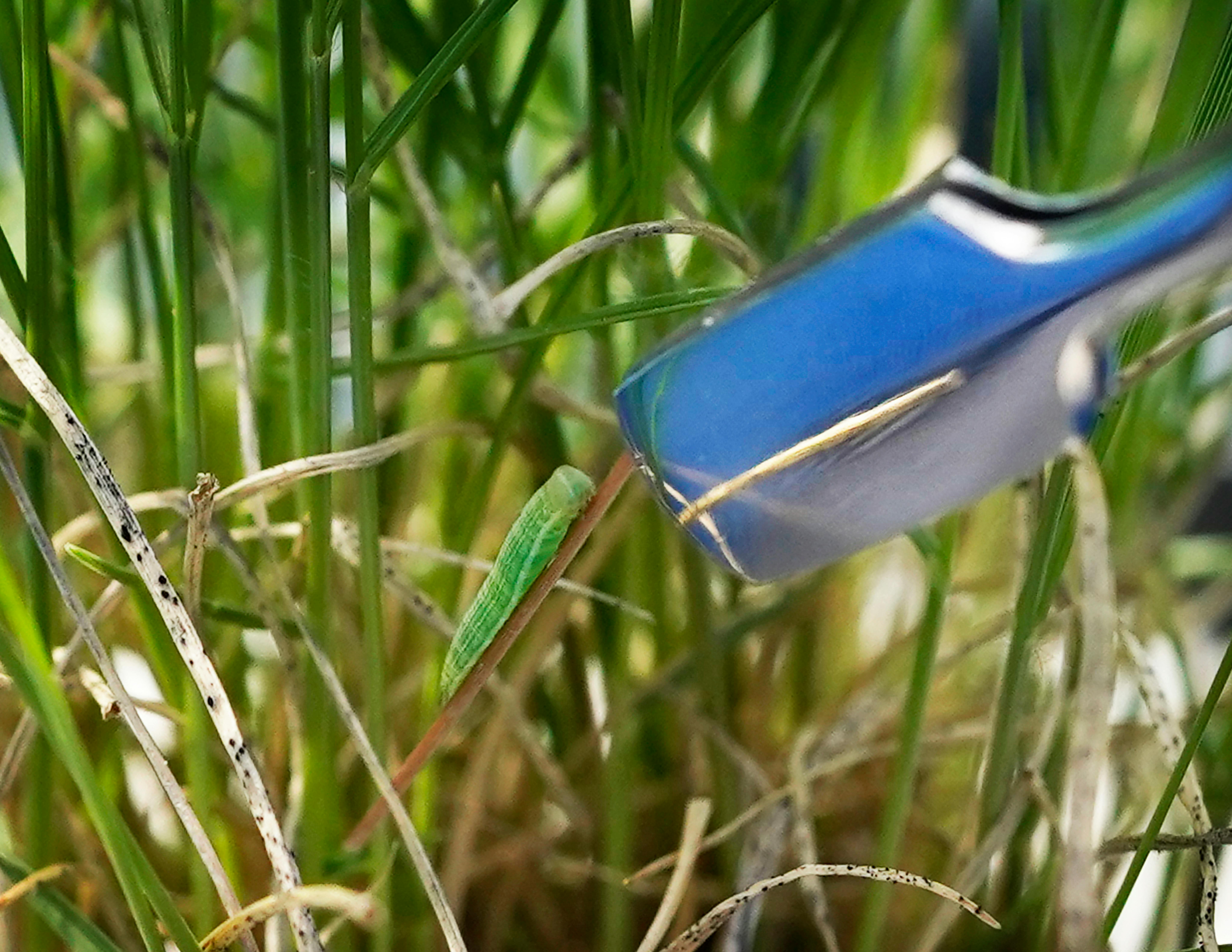
It's one of a handful of butterfly reintroductions going on across the country. Entomologist Jaret Daniels at the Florida Museum of Natural History, who helped reintroduce the Miami blue and Schaus swallowtail in Florida, said he doesn't think any butterflies have been reintroduced to the point they can survive without continued conservation work such as captive breeding.
Mimicking winter conditions has been the biggest of many lessons in rearing Poweshiek skipperlings, said Nordmeyer, who pioneered the husbandry of the species. It's critical to get the humidity of a deep snow cover right, one that would help insulate the caterpillars all winter. If the plaster keeps them too humid in the freezer, they grow mold and die. Too dry, they desiccate and die. One particular brand — Hydro-Stone gypsum cement — has been the project's Goldilocks of plasters.
"It's the one thing I haven't had to change in six years," Nordmeyer said.
As he spoke, caterpillar after caterpillar woke up healthy, green and alive.
By the end of June, Nordmeyer's caterpillars were molting into chrysalises in their cages — narrow 18-inch towers filled with prairie dropseed grass. The structures were covered with the cut-off legs of nylons. Children's pantyhose, to be exact.
Nordmeyer said he experimented with 30 different brands to find ones that were durable but have a large enough mesh to allow critical UV rays to pass through. He finally found them, and buys them by the shelfload from a big-box retailer.
"I don't think they believed me when I said what I was doing," Nordmeyer said.
He rolled up a nylon on one tower to show off a female caterpillar, still munching on grass. She was a bit late. Most of the others had already pupated and he may need to speed her up. For others, he was trying to slow down the metamorphosis, cooling the chrysalises in an environmental control chamber.
Timing is crucial. The butterflies at the zoos in Michigan and Minnesota need to emerge at precisely the right time to match the wild ones. After all, the insects only live as butterflies for about a week in the wild. That's how much time they have to find a mate and lay eggs to ensure another generation survives. If the captive butterflies emerge just a couple days too early or too late, they could be out of sync with their wild counterparts and miss their chance to breed.
On July 4, Nordmeyer packed up the cargo of chrysalises in a Minnesota Zoo-branded Subaru and drove 12 hours to the Michigan fens — groundwater-fed wetlands. Because of the late spring, he'd already delivered a batch in May to the John Ball Zoo, which has been breeding the butterflies.
No one knows why a prairie butterfly is holed up in a wetland complex between Detroit and Flint. They may have been pushed there as they lost habitat, hemmed in by suburbia. Wetlands are where humans aren't, he said.
When he arrived at the fens in Michigan, Nordmeyer got a shock. The butterfly's population in the wild there had crashed even further. Where Nordmeyer and the team expected to spot one or two dozen a day in the Michigan fens, they were finding fewer than five. Was it the late spring? Last year's controlled burn in one of the fens? No one knew.
Shaken, Nordmeyer stood in the gravel outside his lab at a municipal maintenance garage in central Michigan and assessed the situation.
"This is almost the death rattle of a species on the brink," he said. "We're really on the edge here."
An emergency meeting with the U.S. Fish and Wildlife Service in Bloomington, Minn., was set for 12:30 p.m. that day.
But first he had five captive-raised butterflies to release. He walked into the mesh tent outside the garage, where Poweshieks were emerging and perching on potted black-eyed Susans.
He quickly anesthetized a male and used a marker to dab two dots on the wing, one blue and one black. Then returned the marked male to a cage to breed, and coaxed five butterflies into plastic tubes. He drove them, safe in his orange backpack, down a winding dirt road to a lake.
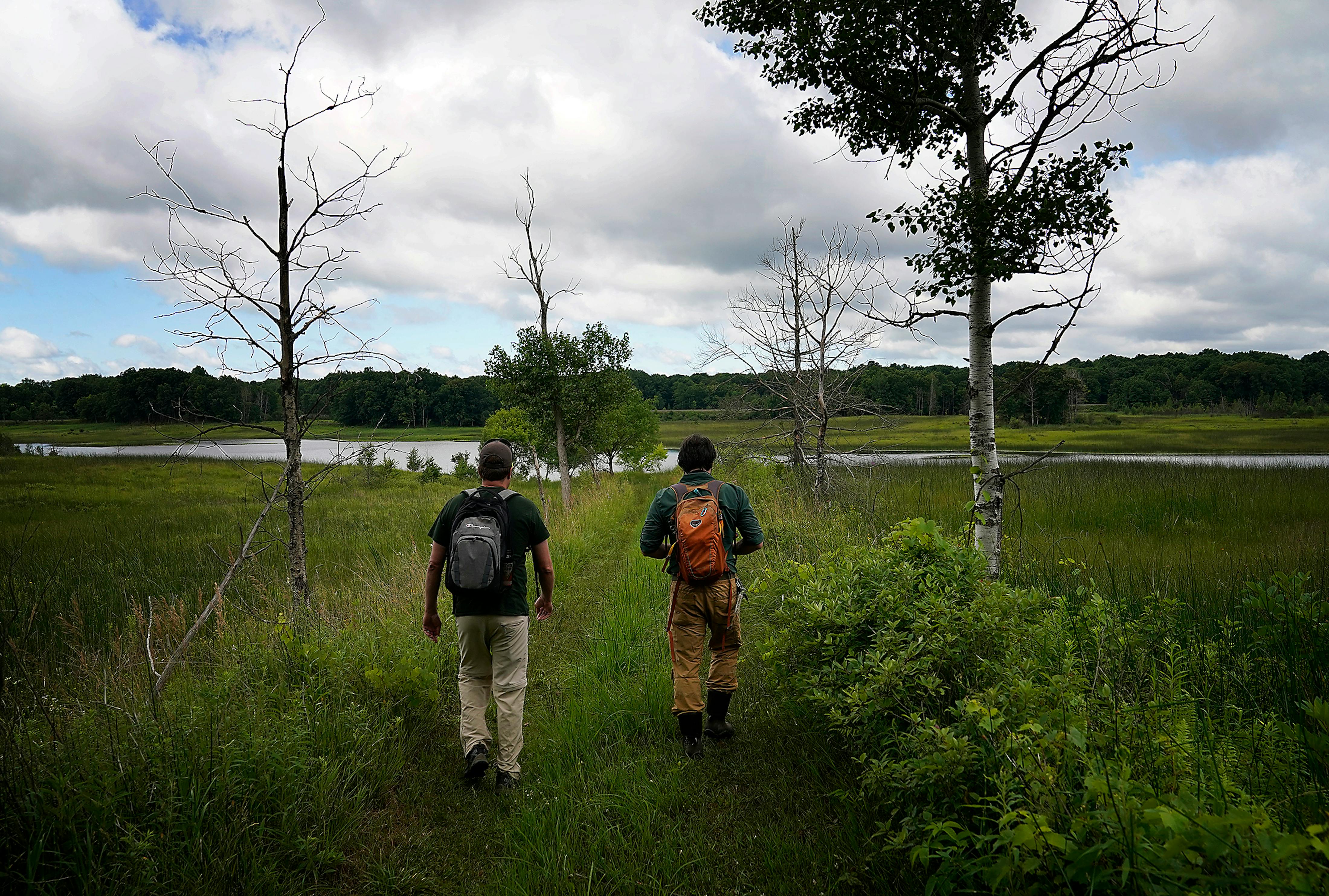
The only way to reach one of the Michigan fens where the wild butterflies survive is by boat — in this case, a township rowboat since someone had stolen Nordmeyer's kayak. He draped his binoculars and Android tablet around his neck, and pushed the boat into the water.
On the other side, the fen sloped up, colorful and rich with milkweed and the Poweshiek skipperling's favorite nectar sources: black-eyed Susans and shrubby cinquefoil with its small yellow flowers. It's the kind of well-managed conservation habitat essential for releasing butterflies.
In the past, half the flowers would have had a Poweshiek on them, he said. Now, none do.
"This is kind of it," he said, looking around.
His 700-mile trip from Minnesota covered what should have been the butterfly's habitat the whole way, he noted. Now he had to go that distance merely to find any of them in the wild, in a spot the size of a Target parking lot.
He knelt down in the sedges and grass and took out the tubes. One by one he coaxed three butterflies onto a slender watercolor paintbrush. He placed each gently on a flower. To Nordmeyer, they're not children or pets, but something like co-workers.
"Back into the wild," he told them.
He rowed back across the lake to release the other butterflies on a sunny slope.
All things considered, it was a good morning — full sun, just what Poweshieks want to mate and lay eggs. Nordmeyer returned to the garage and misted some newly emerged butterflies and offered them a honey-sugar water concoction on a cotton swab.
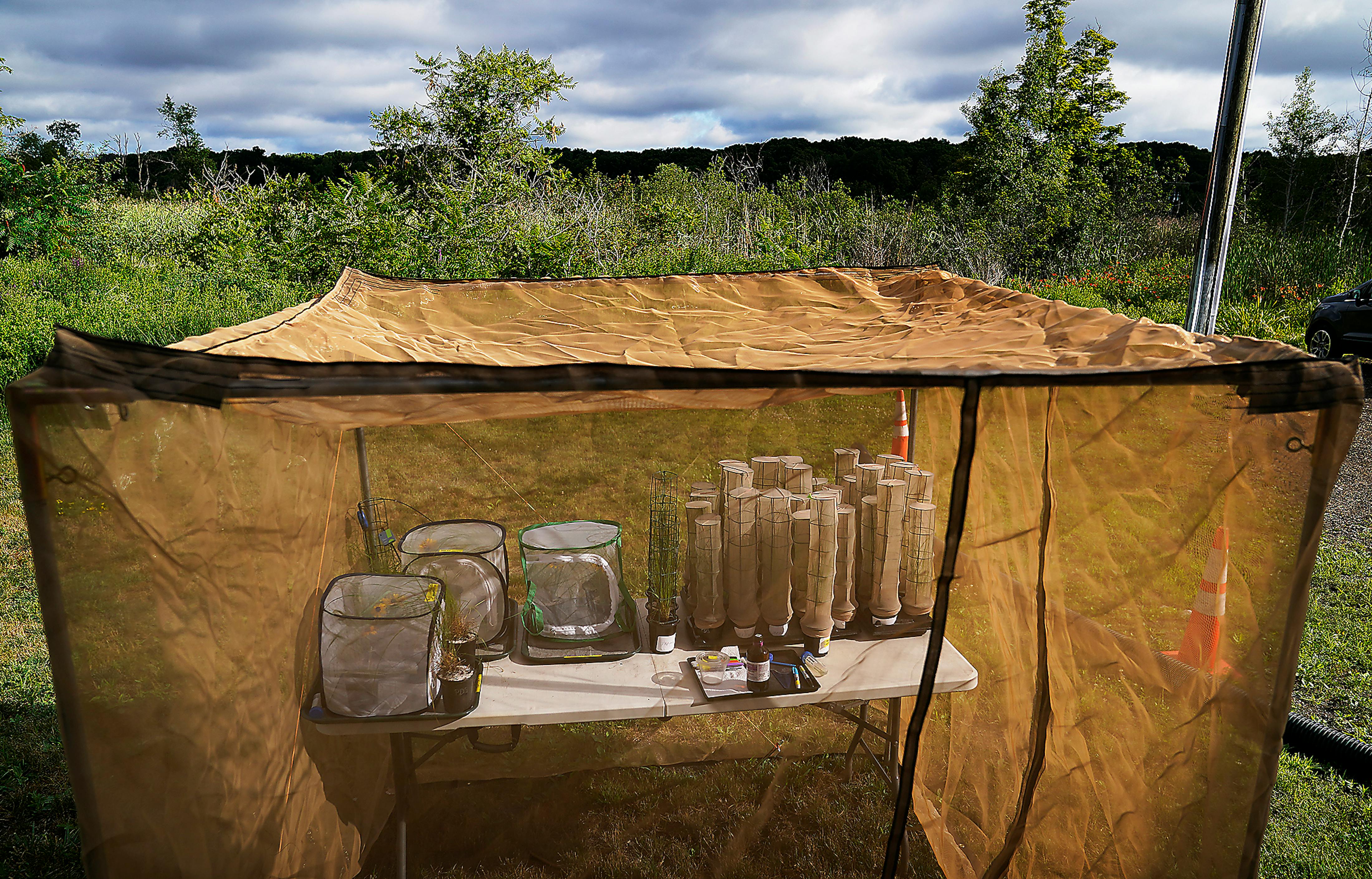

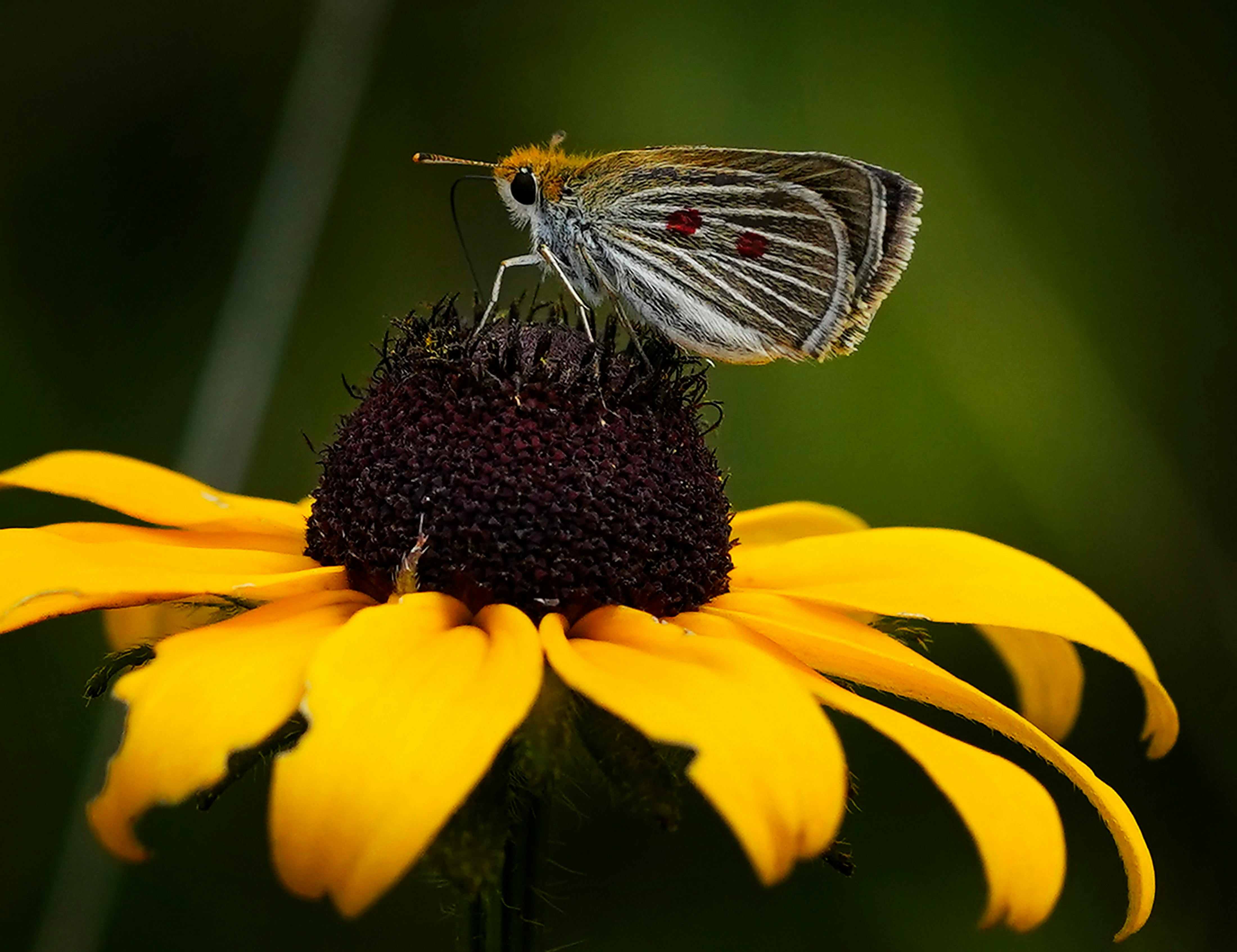
Then came the phone call. On the line was Tamara Smith, national lead for the Poweshiek recovery with the U.S. Fish and Wildlife Service in Minnesota, and other species experts. They agreed the alarming drop in Michigan's wild population demanded a shift in strategy — a pivot from large releases of captive-raised butterflies to collecting more in the wild for more aggressive captive breeding efforts. That's a form of insurance to try to save the genetic diversity of the species.
Smith's office quickly modified the scientific recovery permit it issued for handling a federally listed species so the team could immediately collect more butterflies from the wild.
"It's terrifying," said David Pavlik, an associate researcher with the Nick Haddad Lab at Michigan State University who was on the phone call. "We thought we had a little more time."
It turned out the small Canada population didn't suffer the same crash.
Pavlik runs the Poweshiek breeding program in partnership with the John Ball Zoo in Grand Rapids. There, in the forest above the hillside zoo displays, a collection of butterfly houses sat on tables outside two large hoop houses. In each were a male and female butterfly. Pavlik sat in a chair watching them intently, cheering on each flirtation.
When the sun ducked behind the clouds, the Poweshieks sat still. When it returned, they got frisky and flitted around. Their mating behavior is a mystery, Pavlik said.
It had been an exciting day. A highly valuable male butterfly, whose mother came from a different Michigan fen near where Nordmeyer rowed the boat, had mated with a captive-bred female. The hope is he would bring badly needed DNA from that community to strengthen the genetic diversity of the captive population.
And then to everyone's astonishment they discovered a lone wild Poweshiek in that same fen the next day — the only one at that spot all summer.
"I just could not believe what was in front of me," said Summer Eckhardt, the 23-year-old insect technician at the Michigan Natural Features Inventory who spotted it. "We'd been looking there for at least three weeks." She called her mother about it that night.
Nordmeyer showed off the butterfly in the lobby of his hotel. She was nested in an insulated lunch bag with chill packs; a male was already picked out for her.
"This is huge," Nordmeyer said. "For all we know this is the last Poweshiek skipperling from that site."
There she was in a plastic vial, oblivious to the commotion she had created. Nordmeyer was admiring: "She's just a little chunker."
They named her Lil' Summer, and the eggs she laid were among more than 900 Poweshiek skipperling eggs Nordmeyer drove back from Michigan to the Minnesota Zoo. Most hatched. Hers did not.
Nordmeyer does not budge in his determination. It's the reality of life on the edge, he says. He prefers to ride the many wins they've had learning to raise and tend a butterfly that no one knew anything about before it suddenly disappeared from Minnesota.
Standing in a hoop house at the Minnesota Zoo in August, Nordmeyer is surrounded by part of the new crop of Poweshiek caterpillars, more than 100 munching away on prairie dropseed grass in their tower cages covered by nylons. Chilled water piped around the cages helps maintain an even temperature. They are part of the largest group of Poweshiek caterpillars the zoo has ever had — 667 caterpillars that could just possibly rescue their species. A similar size group is feeding at the John Ball Zoo.
The first are molting.
Sometime around October or November, the grass will die and turn brown and the green caterpillars will just sit there. Then, when the temperatures drop below freezing for several nights, Nordmeyer will move them to the freezer for the long winter, hoping he and other researchers will learn the key that will bring them back.
Share your story
Please share feedback, questions and suggestions by using the form below. Our reporters will not share your information without your permission. Thank you.